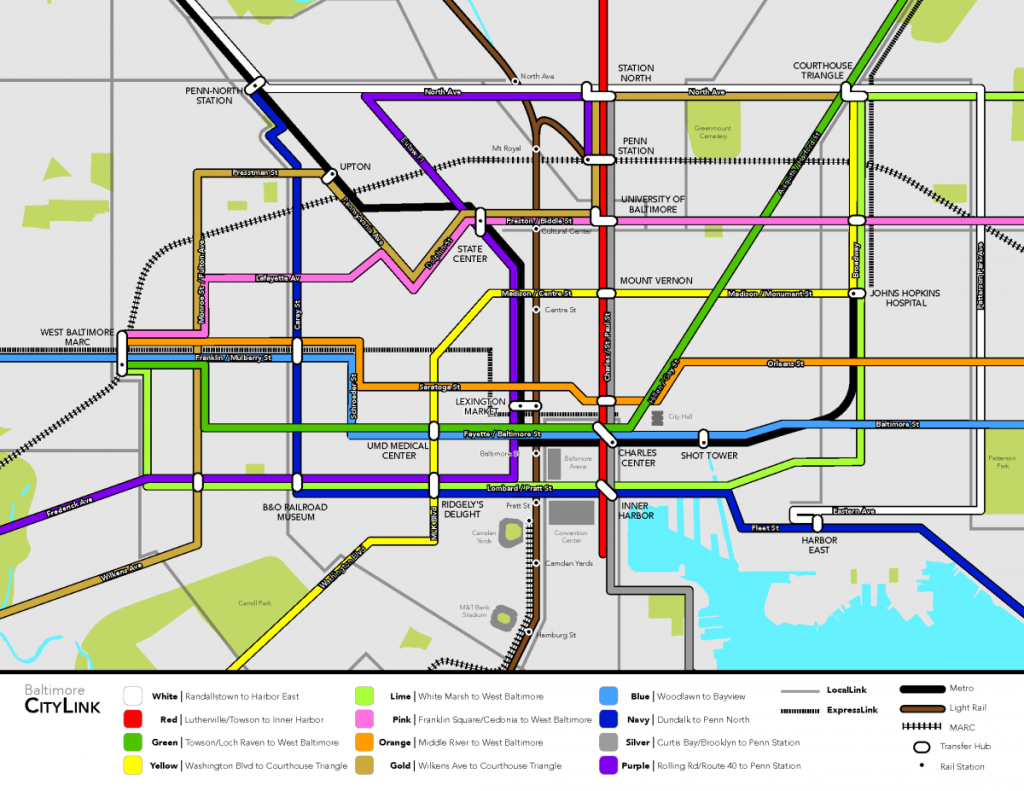 Governor Larry Hogan announced $135 million in targeted investments to transform and improve transit throughout the Baltimore metropolitan area. The multi-phase plan will create an interconnected transit system, known as BaltimoreLink, and includes redesigning the entire local and express bus systems throughout Baltimore and adding 12 new high-frequency, color-coded bus routes that improve connections to jobs and other transit modes.
Governor Larry Hogan announced $135 million in targeted investments to transform and improve transit throughout the Baltimore metropolitan area. The multi-phase plan will create an interconnected transit system, known as BaltimoreLink, and includes redesigning the entire local and express bus systems throughout Baltimore and adding 12 new high-frequency, color-coded bus routes that improve connections to jobs and other transit modes.
The BaltimoreLink system will deliver a unified transit network and includes renaming existing Maryland Transit Administration (MTA) modes: LocalLink (Local Bus), Light RailLink, Metro SubwayLink and MobilityLink to create an interconnected transit system. Other key elements of the BaltimoreLink system include transitways, transit hubs and transit signal priority.
A major component of the BaltimoreLink system is CityLink – 12 new, high-frequency, color-coded bus routes that will improve reliability and better connect riders to Amtrak, Commuter Bus, Light RailLink, MARC Train, Metro SubwayLink and other services in Baltimore and the surrounding suburbs. In Baltimore City, new CityLink routes will run every 10 minutes during peak periods and every 15 minutes during the midday. The new CityLink buses will be specially branded and travel on color-coded routes with easy-to-read signage and detailed maps that will make the system easier to use. The CityLink bus routes, Light RailLink and Metro SubwayLink will form an interconnected, one-transfer system. On the new system, a rider will be able to get from any stop to any other stop with only one transfer.
Our plan will provide more people access to 745,000 jobs through an interconnected transit system:
- Over 130,000 more jobs will be accessible via high-frequency transit compared to the existing network – a 36.7% increase
- 205,000 more people will have access to high-frequency transit compared to the existing network – a 34% increase
- 30,000 more people will have access to transit by increasing the service area by approximately 18 square miles
__________________________________
Will Governor Hogan’s Baltimore Transit Plan Work?
ROCKVILLE, MD (November 11, 2015) — The Maryland Public Policy Institute today released a new study examining BaltimoreLink, Governor Larry Hogan’s proposal to transform transit in the City of Baltimore. The governor’s plan is expected to provide access to 745,000 jobs in the region and create north-south and east-west bus lanes as well as hubs to connect transit and improve access for riders and cyclists. The full study can be found at this link.
“BaltimoreLink is a bold attempt to fix a broken transit system,” said Christopher B. Summers, president of the Institute. “City residents need a seamless transportation link to the region’s economic opportunity centers, such Towson, Columbia and Fort Meade. Our study examines whether BaltimoreLink can deliver faster, flexible and more reliable transportation for the region without busting public budgets.”
The study, written by policy analyst Nick Zaiac, includes the following key findings:
High frequency bus lines fit Baltimore: Baltimore is better suited to a larger network of bus lines than a few costly rail lines. The new service, Baltimore CityLink, will have 10-minute on-peak and 15-minute off-peak service, and will be laid out in an understandable format, with a map resembling typical rail service. It will provide a one-transfer link between each bus line and the city’s current rail-based system, correcting many of the typical complaints about bus service, including the problem of chronically unreliable buses.
Transitways will be key to CityLink’s success: For CityLink to succeed, dedicated bus corridors will be necessary along some downtown streets. Downtown traffic is typically the biggest cause of the delays that make many current bus systems unreliable. In addition to moving commuters faster, dedicated lanes can eliminate conflicts with potential drop-offs, deliveries or illegal parking along the roadway edge.
Private car-sharing concept adds new possibilities: The Maryland Transit Administration has issued a request for proposals from companies to provide car-sharing services at MTA rail stations. A car-sharing service would provide commuters extra mobility to and from public locations and enable private sector partners to help solve transportation challenges the public sector has been unable to solve on its own.
Download the fill report at mdpolicy.org.












